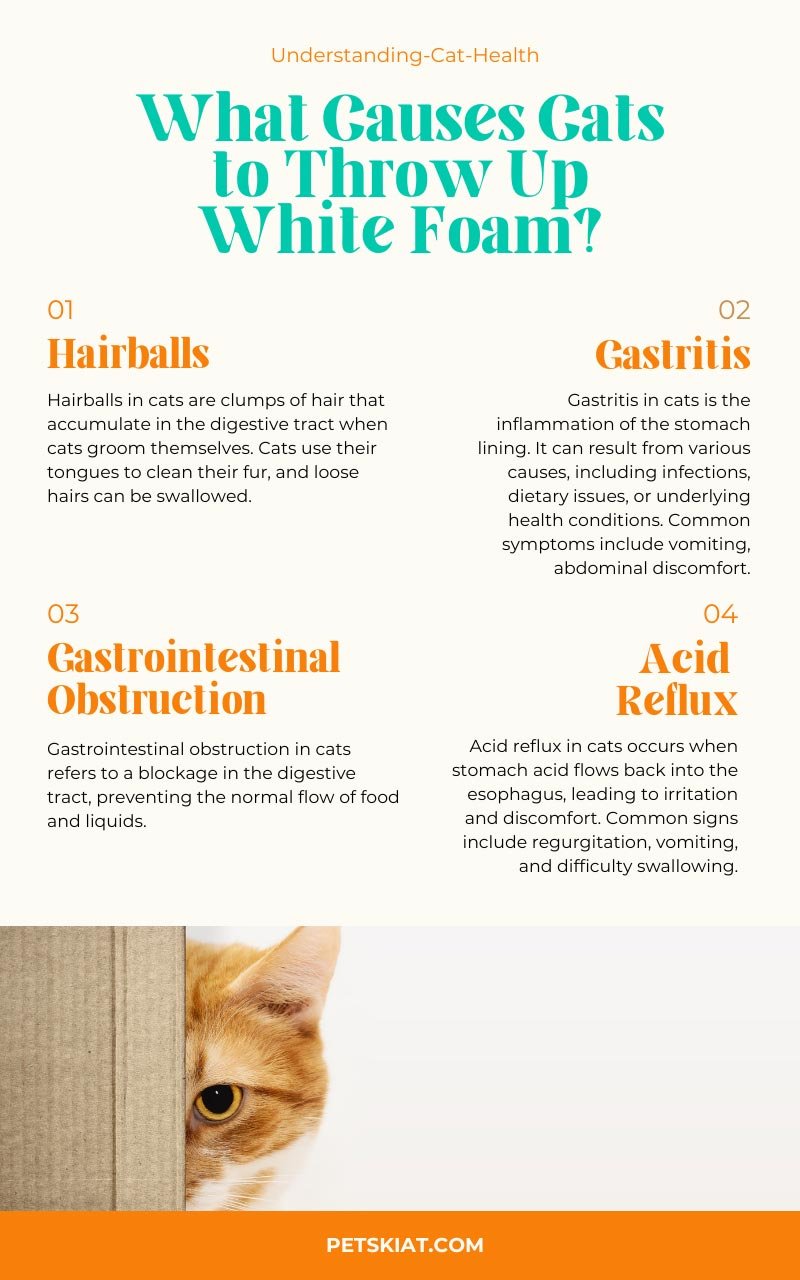It’s only natural for us cat owners to worry when our beloved furry companions show signs of unusual behavior, particularly when it involves their health. A frequent cause for concern among cat owners is witnessing their cat vomiting white foam.
In this article, we will look into the possible causes for this behavior and some advice on how you can support your cat during such situations.

What Causes Cats to Throw Up White Foam?

When a cat vomits white foam, it can be an indication of several underlying issues. Here are some of the possible causes:
1. Hairballs
Cats, especially those with long hair, commonly deal with hairballs. During grooming, cats ingest loose hair, which can accumulate in their stomachs. This buildup may lead to irritation, prompting vomiting that often includes the expulsion of white foam.
2. Gastritis
Gastritis, characterized by inflammation of the stomach lining, is another potential cause of white foam vomiting in cats. This condition may arise due to various factors, including dietary issues, infections, or stress. Changes in diet or exposure to stressful situations could contribute to the onset of gastritis.
3. Gastrointestinal Obstruction
White foam vomit might signal a gastrointestinal obstruction, where an object like a foreign item or a hairball blocks the normal passage of food through the digestive system. If your cat displays additional symptoms such as a decreased appetite or abdominal pain, it is crucial to seek prompt veterinary attention to address potential issues with the digestive tract.
4. Acid Reflux
Just like humans, cats can also experience acid reflux. This happens when stomach acid flows back into the esophagus, causing irritation and discomfort. In some cases, this can lead to vomiting, which may include white foam.
When to Consult a Veterinarian
While occasional vomiting is not uncommon for cats, it is important to monitor your cat’s behavior and seek veterinary attention if necessary. Here are some signs that indicate it is time to consult a veterinarian:
- Frequent vomiting situations
- Loss of appetite or weight loss
- Lethargy or weakness
- Bloody or black vomit
- Abdominal pain or discomfort
If you notice any of these symptoms, it is best to consult a veterinarian who can assess your cat’s condition and provide appropriate treatment.
How to Help Your Cat

If your cat is throwing up white foam but is otherwise acting normal, there are a few things you can do to help:
1. Monitor their behavior
Keep an eye on your cat’s behavior and look for any patterns or triggers that may be causing the vomiting. Note any changes in their diet, environment, or routine that could be contributing factors.
2. Adjust their diet
Consider switching your cat to a specialized diet that helps reduce hairballs or is gentle on their stomach. Consult with your veterinarian to determine the best dietary options for your cat’s specific needs.
3. Provide plenty of water
Ensure that your cat has access to fresh water at all times. Staying hydrated can help prevent dehydration and support overall digestive health.
4. Reduce stress
Cats can be sensitive to changes in their environment, which can lead to stress and digestive issues. Create a calm and comfortable space for your cat, and try to minimize any potential stressors.
Conclusion
While it can be concerning to see your cat throwing up white foam, it is often a symptom of a treatable condition. By understanding the possible causes and taking appropriate action, you can help your cat maintain their health and well-being. Remember, if you have any concerns or if the vomiting persists, it is always best to consult a veterinarian for professional advice and guidance.




